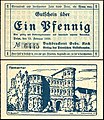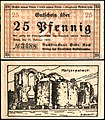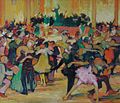Fritz Quant
Fritz (Franz Xaver Friedrich) Quant (born February 18, 1888 in Trier ; † November 3, 1933 there ) was a German graphic artist, painter and designer.
Origin and basic education
Fritz Quant was the oldest child of the master cooper and innkeeper Hermann Quant and his wife Barbara nee. Mendel. He began his basic training with an apprenticeship with the church painter Peter Thomas, which he completed in 1908 with the journeyman's examination. In addition to his job, he also attended the Trier craft and applied arts school as a “painter's assistant” with a focus on painting with August Trümper and interior design with Hans Proppe . In 1912 he passed the so-called artist year and joined the army as a volunteer. However, his military service was only a short interlude, as he was unfit for military service due to illness.
Artistic career
For further training, Fritz Quant studied during 1915 at the reformed State Academy for graphic arts and book trade in Leipzig , which was headed and reformed for many years by Max Seliger , and there he learned the technique of etching in Alois Kolb's well-known graphics class .
Subsequently, until 1918, he took on the teaching position of August Trümper, who was drafted into the Landsturm, at the Trier School of Applied Arts.
With a special permit from Richard Riemerschmid , director of the Kunstgewerbeschule in Munich, Fritz Quant was able to study there under Robert Engels and Adolf Schinnerer from 1920–1922 . In doing so, he also found a connection with a moderate modernism, that particularly flourishing in the Munich art scene of the "golden mean", fed by French post-impressionism and a defused German expressionism , which can be classified in retrospect under the art-historical collective term of "expressive realism" . She influenced Fritz Quant as well as his fellow students from his native Greater Region, Peter Krisam (1901–1985) from Trier , Mia Münster from Saarland and Joseph Kutter from Luxembourg in his early work.
Fritz Quant lived in Trier, married to Mieze (Maria) Scherzberg (1901–1976) childless since 1925, as a freelance artist; only in the last three years of his life employed him as a teacher at the Trier arts and crafts school. Quant was well connected within the Trier art scene. As a member of the "Trier Artists 'Guild", the major artists' association of the Rhine, Moselle and Nahe Artists 'Union Westmark , the Trier artists' group "Die Freie Vereinigung" and the society "Bildende Künstler und Kunstfreunde eV Trier", he exhibited regularly. Nationwide he joined the “New German Artists Guilds - NKG” and the “Association of German Commercial Graphics” BDG. After the National Socialist seizure of power and the transfer of all associations to Nazi organizations, Quant was accepted into the Trier district group of the Reich Cartel of Fine Arts in September 1933 and given the state license for commissions and exhibitions.
Works
The catalog raisonné
The 1994 exhibition catalog of the Stadtmuseum Simeonstift Trier contains a comprehensive catalog raisonné compiled by the authors Christine Beier and Heinrich Nebgen with a total of 376 items from Quant's universally designed fields of work, including 57 works of free painting (paintings, tempera, oil sketches, pastels and watercolors). The largest work blocks are made up of drawings and prints as well as applied arts, especially interior design.
graphic
Fritz Quant achieved considerable popularity as a "black and white artist" at an early stage. His series of etchings, lithographs and duplicated pen drawings, in which he created views of his hometown Trier, the Moselle region and the Eifel, quickly made him known. He combined a masterly mastered technique, also in the combination of different graphic processes, with conventional realism in the motif. He often reproduced his monuments, quiet corners or landscape sections seen from an unfamiliar point of view with a “ballad-like, melancholy” mood content (illustration: St. Matthias Basilica from the north). But he also created less “covered” representations such as his pen drawings of the “Moselle castles” (illustration: Burg Arras), which he successfully marketed in folders of 6 or 15 sheets and as book illustrations for Heinrich Tiaden's travel report “Burgenzauber an der Mosel” . The corresponding templates (pencil sketches and recordings with a plate camera on site) were created in 1917 on a two-week Moselle bike tour with the author.
"Roman Bridge" (before 1921), dimensions: 223 mm x 168 mm
Judengasse in Trier , 1917 or earlier, dimensions: 300 mm x 135 mm
Chalk and pencil drawing: Benedictine Abbey of St. Matthias (1919), 395 mm x 230 mm.
Applied graphics
As in the example of “Moselle castles”, free and applied graphics are often intertwined at Quant. The popularity of his views earned him a variety of commissions for the design of advertising materials, especially in the areas of the wine trade and the tobacco industry (wine labels, wine lists, business stationery and packaging). He designed local emergency notes , certificates of honor, family advertisements, private bookplates and devoted himself in detail to artistic book decoration. The extensive illustrations for the advertising brochure “Rheinlands Weine”, the highly regarded reconstruction drawing of the Roman tomb of Igel for the standard work of the same name by Dragendorff / Krüger or the covers of the periodicals “Trier Zeitschrift” and “Trierische Heimat” all came from his hand.
1 Pfennig Notgeldschein (1920), VS: a quote from the Trebeta saga , RS: Porta Nigra
2 Pfennig emergency bank note (1920), back cover: Trier Cathedral and Church of Our Lady
25 Pfennig emergency money note (1920), RS: Kaiserthermen
50 Pfennig emergency bank note (1920), RS: Kornmarkt
Ten million Mark emergency bank note (1923), RS: City view of Trier after an engraving by Merian (1646)
One hundred million mark emergency bank note (1923), back: Römerbrücke
One billion mark emergency money note (1923), RS: Trier main market
Free painting
Free painting came up short in Fritz Quants' short life. The artist's potential was already shown in his painting “Munich Carnival” with its generous brushwork and an expressiveness of the colors that underlined the lively dance motif. Equally independent and remarkable were his landscapes with low horizons, over which he stretched grandiose cloudy skies, so u. a. in his “view of Trier from the west”, which in another version was presented to Reich Chancellor Gustav Stresemann as a gift when he took office. But Quant's numerous projects in other fields only resulted in a relatively narrow oeuvre of easel painting, also owing to his livelihood. There were mainly views from the greater region, brightly colored and reduced to striking form elements such as “Bernkastel”, “Weinfelder Maar” or “Saarburg”. Some subtle flower pieces completed the work.
Interior design
In the last decade of his life, Fritz Quant devoted himself mainly to interior design, despite his poor health. The development of room concepts and the painting of more than 30 sacred buildings and profane objects such as churches, chapels, official buildings, school halls, museum rooms and inns prove his enormous productivity in this area. Destruction in the war, alterations or repainting, however, with a few exceptions, such as the large conference room in the old town hall in Wittlich, drowned out these total works of art. As far as postponed spatial art designs by Quant and contemporary reviews allow an assessment, his predominantly ornamental painting moved between the poles of a bourgeois, conservative late historicism with elements of Art Nouveau and expressionistic influences with strong, contrasting color choices, right up to the unusual black as the wall color. His spatial art was commissioned art.
Legacies and Honors
On October 28, 1959, Fritz Quant's widow and heiress bequeathed his artistic estate of oil paintings, drawings, copper plates / etchings to “his beloved hometown Trier” and asked for the work to be kept in memory of the painter. After her death in 1976, over 400 works from all areas of the artist's work, including the copper plates of the printmaking as well as personal documents and objects, came to the city of Trier and the city museum Simeonstift Trier. In the same year, the city of Trier named a street in the Feyen / Grafschaft development area after Fritz Quant. They also granted a grave of honor in the Trier main cemetery, where the painter and his wife rest.
Exhibitions
- 1916 - Trier. Solo exhibition in the Provincial Museum (today Rheinisches Landesmuseum Trier).
- 1916 - Cologne. Kölnischer Kunstverein: "Art from private ownership in Cologne"
- 1917 - Trier. Exhibition "Front und Heimat" in the Provincial Museum.
- 1917 - Munich. Summer exhibition of the German Association of Artists "The Jury Free eV"
- 1919 - Trier. Christmas studio exhibition of the painter in his "spacious glass hall in the garden field".
- 1920 - Trier. Trier artists' guild. Exhibition in the business premises of the "Blauer Hand", Brotstrasse, as part of the "Trier Art Week".
- 1924 - Trier. Free exhibition in the “Autofag House” in Trier, Simeonstrasse.
- 1924 - Trier. Trier artists' guild. Christmas exhibition in the "House of Venice".
- 1925 - Trier. Art and trade exhibition in the craft and applied arts school.
- 1926 - Trier. Solo exhibition in the Provincial Museum.
- 1926 - Trier. Free Association of Trier Artists, exhibitions in the Lintz book and art store (July) and in the Provincial Museum (November).
- 1927 - Trier. Free Association of Trier Artists, exhibition in the Provincial Museum.
- 1928 - Trier. Free Association of Trier Artists, Christmas exhibition in the Provincial Museum.
- 1929 - Trier. Christian art exhibition, group exhibition with sculptor Anton Nagel.
- 1929 - Trier. Free exhibition "The practical home" in the municipal sound hall.
- 1930 - Trier. Exhibition of the Society of Fine Artists and Art Lovers in the casino
- 1933/34 - Trier. Memorial exhibition in the Provincial Museum.
- 1978–1980 - Cairo (Goethe Institute), Herzogenbusch and Gloucester (twin cities of the city of Trier), Barr (Alsace), Strasbourg and Liège, “Trier views”, traveling exhibition of Trier painters.
- 1981 - Trier. Municipal Museum Simeonstift, exhibition of the entire artistic estate.
- 1994/95 - Trier. City Museum Simeonstift. Retrospective with catalog.
- 2013 - Wittlich. Gallery in the old town hall, "Gesamtkunstwerker - The painter, graphic artist and designer Fritz Quant" (Fritz Quant on his 125th birthday - from the collection of the Simeonstift city museum and others).
literature
- Elisabeth Dühr (Ed.): Fritz Quant (1888–1933) - A painter and graphic artist from Trier. Catalog and catalog raisonné for the exhibition from November 20, 1994 to February 26, 1995 in the Städtisches Museum Simeonstift Trier. Texts: Christine Beier and Heinrich Nebgen, Trier 1994.
- Johannes Mumbauer : Fritz Quant, a Trier eraser. In: Kur-Trier No. 6, November 1917, pp. 91-93.
- “Moselburgen” - 6 or 15 sheets based on original pen drawings by Fritz Quant, Kommissions-Verlag Fr. Lintzsche Buch- und Kunsthandlung Trier, undated (1919); several copies in the artist's estate, Stadtmuseum Simeonstift Trier.
- Heinrich Tiaden: Castle magic on the Moselle. Happy artist rides in a land of bliss. With pen drawings by Fritz Quant. Ms. Seybold's Verlagbuchhandlung, Munich 1920.
- Wilhelm Blatt: Heimatkunst in the 1st exhibition of the Trier artists' guild. In: Kur-Trier No. 6, November 1920, pp. 89-91.
- Hans Dragendorff / Emil Krüger: The tomb of Igel, Trier 1924, plate 20.
- Rhineland wines - Moselle - Saar - Ruwer. 4th booklet of the scriptures, ed. from the Propaganda Association of Prussian Wine-growing Regions, Bonn 1928.
- Paul Mauder: Trier painting - Trier painter groups and Trier painters. In: Trierische Heimat, 7th year, issue 7, April 1931, pp. 97–99; Issue 8/9, May / June 1931, pp. 117-119 and Issue 10, July 1931, pp. 152-153.
- Ulrich Thieme / Felix Becker (eds.): General Lexicon of Visual Artists from Antiquity to the Present, Volume 27, p. 498, Leipzig, 1933 (unaltered reprint Leipzig 1999).
- Matthias Mehs: Fritz Quant as a painter of his homeland. In: Trierische Heimat, Vol. 10 (1933/34), pp. 73–75.
- Hans Vollmer (Hrsg.): General Lexicon of Fine Artists of the XX. Century, 4th volume, p. 1, Leipzig 1958 (unaltered reprint Leipzig 1999).
- Reinhard Heß: Fritz Quant, the painter. In: New Trierisches Jahrbuch 1967, pp. 53–56 with figs. 12 and 13.
- Rainer Zimmermann: The Art of the Lost Generation - German Painting of Expressive Realism. Düsseldorf and Vienna 1980; the same: expressive realism painting. In: Museum Expressive Realism - Painting in the 20th Century, Neues Schloß Kisslegg, Stuttgart undated (1992), pp. 5–10.
- Dieter Ahrens: The work of Fritz Quants in the Municipal Museum Simeonstift. In: New Trierisches Jahrbuch 1981, pp. 53–54.
- Elisabeth Dühr / Richard Hüttel (ed.): Travel in pictures. Views of the Moselle from William Turner to August Sander, exhibition catalog, Trier 1996, pp. 200–203.
- Bärbel Schulte: Quant, Fritz, painter and graphic artist. In: Heinz Monz (Ed.): Trier Biographisches Lexikon, Trier 2000, p. 350.
- Monika Joggerst: The class for painting 1930–1969. In: Bärbel Schulte (Hrsg.): "For the refinement of forms and taste education" - the Trier Werkkunstschule. Catalog manual for the exhibition of the same name. Städtisches Museum Simeonstift Trier, 25 May - 31 October 2003, Trier 2003, pp. 161–198 a. Short biography p. 430.
- Bénézit Dictionary of Artists, Edition Gmünd, Paris 2006, Volume 11, p. 521.
- Richard Hüttel, total artist Fritz Quant, flyer for the 2013 exhibition in Wittlich.
Individual evidence
- ↑ Biographical and artistic estate in the City Museum Simeonstift Trier.
- ^ Heinrich Nebgen: Thomas, Peter, painter, church painter and restorer. In: Heinz Monz (Ed.): Trier Biographisches Lexikon, Trier 2000, p. 465/66; Elisabeth Schaumann-Schwarz: The painter Peter Thomas. In: New Trierisches Jahrbuch 1984, pp. 157–159 with Fig. 40.
- ↑ Book gift with dedication: "To the painter's assistant Fritz Quant as an award for hard work and good performance in painting from nature and portrait drawing in the school year 1908. Trier, April 18, 1909. The director Skomal". Privately owned.
- ↑ Edmond Thill: Joseph Kutter. In: Elisabeth Dühr (Hrsg.): Exhibition catalog “Painter friendships in threatening times - the 30s in the region”, Städtisches Museum Simeonstift Trier, Trier 2001, pp. 21–33 regarding the Luxembourg painter Joseph Kutter.
- ↑ exhibition catalog as before; Elisabeth Dühr: Peter Krisam pp. 35–52; Christl Lehnert-Leven: Mia Münster, pp. 53–64 as well as introduction with synopsis of the artist's works, pp. 11–19.
- ↑ The artists' associations mentioned all came into being between 1920–1930. By far most of the exhibitions ran without an accompanying catalog, with the exception of the Trier Art Week. Edited by the Trier Artists' Guild. Artistic directors: Fritz Quant and Tony Wendling. Trier 1920, p. 11 - Fig. Fritz Quant, Burg Arras, pen drawing 1919; Exhibition guide of the trade show Aug./Sept. 1925 in Trier on the occasion of the millennium of the Rhineland, p. 41/42: Quant as a member of the artists' guild (without specifying the works); Catalog of the art exhibition in the Casino in Trier, Nov./Dec. 1930, p. 19: Quant as a member of the Society of Fine Artists and Art Friends eV Trier, with the listing of 7 works.
- ↑ Willi Geißler (Ed.): Festschrift for the traveling exhibition of the New German Artists Guilds, Hartenstein 1921: Fritz Quant as a member of the painter's guild p. 51. The guild was founded in 1919. Today “Association of German Graphic Designers”. http://www.bdg-designer.de
- ↑ “Development work of the Reich Cartel of Fine Arts. From the district group Trier. “Article without indication of responsibility. In: Trier National Gazette of September 16, 1933.
- ^ Quote from Dieter Ahrens 1981, p. 53, cf. Lit.
- ↑ Trier Journal, Quarterly Issues for the History and Art of the Trier Land and its Neighboring Areas, ed. by the Society for Useful Research and the Provincial Museum, Volume 1, Issue 1, Trier 1926 and subsequent editions.
- ↑ Trierische Heimat, monthly, ed. from the Trierisch Association, Trier, design of the title page by Fritz Quant from year 1, issue 8, May 1925 to year 7, issue 11/12, Aug./Sept. 1931.
- ↑ Beier / Nebgen, cf. Lit. Verz., P. 25 and p. 64: The painting, signed and dated “F. Quant 23 "shows a Dr. WH Kirchner, Berlin and Freundeskreis as donors. Privately owned.
- ↑ As before. The catalog raisonné lists all objects, including the old town hall Wittlich, painting 1923/24, preserved or recently restored.
- ↑ Collection of newspaper clippings in the Quant estate
- ^ Archive of the City Museum Simeonstift Trier.
- ↑ Sandra Ost: Walks through the Trier main cemetery, Trier 2004, p. 80/81.
| personal data | |
|---|---|
| SURNAME | Quant, Fritz |
| ALTERNATIVE NAMES | Quant, Franz Xaver Friedrich (full name) |
| BRIEF DESCRIPTION | German graphic artist, painter and designer |
| DATE OF BIRTH | February 18, 1888 |
| PLACE OF BIRTH | trier |
| DATE OF DEATH | November 3, 1933 |
| Place of death | trier |



















